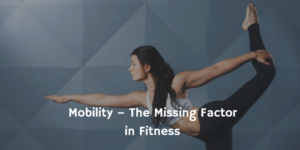If you had to name the most important aspect of fitness, what would it be? Strength? We tend to gauge fitness by muscularity. Someone with big biceps must be in shape, so isn’t muscle mass a good way to measure fitness?
What about endurance? People who run marathons must live long. They’re always thin and spend hours a week – sometimes hours a day – running.
Or perhaps flexibility is the key? One of the characteristics of age is loss of flexibility. Maybe doing yoga into the golden years is the best way to stay fit.
One could name other factors that age management specialists measure – agility, balance, bone density, percentage body fat. And of course, there are lab values that seem to be important like cholesterol and fasting blood sugar.
Mobility
But as one ages, what really matters? I would suggest mobility – the ability to move through your whole healthy range of motion. To get where you want to go and reach out and grasp what you’re after.
Stay with me on this for a minute. I’m not downplaying any of the other factors. Muscle mass and bone density are associated with health in the later years, not to mention freedom from injury. VO2 max – the measured ability of the circulatory system to deliver oxygen to the body, or in other words, aerobic fitness – is one of the best predictors of all-cause mortality. And one should control one’s diet and percentage body fat, along with which come control of blood pressure, blood sugar, and a host of potential maladies. But all of these come together with the concept of mobility.
But isn’t mobility the same thing as flexibility? Can’t I improve mobility by just stretching every day and doing yoga? The answer is no, and here’s why.
Flexibility is the degree to which you can be stretched. It is the range of motion you could allow yourself to be passively moved. Mobility is the range of motion through which you can actively move yourself.
Translated into activities of daily living, this means mobility is your ability to go up and down stairs, to get in and out of cars, to reach for things on the highest shelf. It is the ability to continue to do the things you love whether fishing or skiing, cooking or yardwork.
Mobility = Quality of Life
Most people don’t consider the concept of mobility until they begin to lose it in their later years. We pay our gym membership fees to go someplace and work out. To get strong and lose weight. We seldom pay much attention to flexibility because you don’t need to be a yogi to enjoy a full and active life. But when arthritis starts to appear or a little sciatica injects some pain into your running, you begin to appreciate what loss of mobility really means.
Gymnastics – Not just for gymnasts
If there is a sport that exemplifies the zenith of mobility, it is gymnastics. Gymnasts combine the ultimate in strength, flexibility, agility, balance, and coordination. If you train like a gymnast, no aspect of fitness is neglected.
Gymnastics training is also relatively easy to do outside the gym, assuming you’re training just for fitness, not competition. You don’t need a set of weights to lift or a track to run on. Your body is the weight you lift. For those gymnastics exercises that require some apparatus, I’d recommend an inexpensive gym with wide access like LA Fitness
Weight training tends to focus on exercises that work specific muscles within strict ranges of motion. Form is important. But weight training doesn’t resemble activities of daily living, which tend to be asymmetrical and are characterized by changes in direction and stresses on joints.
Combining strength with stretch
Proper gymnastics training will combine strength exercises with mobility. Every exercise that works a muscle alternates with an exercise that stretches it. This is the best way to ensure that one’s own muscular development does not become one’s prison, making you “muscle-bound.” The great irony of strong men is that they are often only strong within a narrow range of motion. They become less agile and less able to perform their favorite sports – tennis, snowboarding, whatever.
They are also more prone to injury when forced to move suddenly in an unexpected direction. The muscles, ligaments and tendons are strong in the direction they are used to working, but not in others. This is why ankle sprains and knee dislocations occur while playing basketball, softball, or skiing.
Patience
Gymnastics training requires patience. Muscles grow faster than connective tissue and it is easy to overpower a joint that has not been properly conditioned first. Generally speaking, one should undergo at least six months of basic mobility training before even attempting any of the basic gymnastic skills in order to give the connective tissue that support the skills time to develop along with the muscles.
Be patient; it’s worth the wait.








